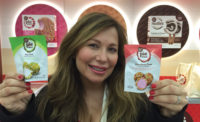
|
| Buyers walk the floor of the Natural Products Expo East. Photo provided. |
At the Natural Products Expo East show held this past September in Baltimore, keynote speaker Alice Waters, often regarded as the mother of the slow food movement, challenged attendees attending the East Coast’s premier gathering for the natural, organic and healthy living food industries.
“In this country, we have to bring people in a very pleasurable way back to their senses,” Waters advised. “We’re not talking about a food trend; we’re talking about sustenance and humanity and the way that we behave toward other people.” She urged everyone – producers, restaurateurs, consumers, educators - to join what she dubbed the “delicious revolution” to encourage sustainable, healthy and fair changes in our foodways.
“These are the same core values that drive the brands and buyers in the natural products marketplace and was reflected in attendance and exhibitors at this year’s show,” says Expo East Show Director Erica Stone.
As Mary Jo Marks, manager of training & education at UNFI (the leading national distributor in the natural food channe)l, points out, despite the recession, chocolate ranks as one of its stronger categories.
“If people are going to treat themselves, they are going to treat themselves well,” explains Marks. “Price points are less of an issue. It’s more about the quality of the ingredients and the certifications.”
According to SPINS, which tracks the natural and specialty products industry, chocolate sales are up 25.7% to $129 million in the combined natural and conventional food, drug and mass channels (including Wal-mart but not Whole Foods) during the 52-week ending September 1.
Fair Trade confectionery products are also very important. SPINS tracked a 17.8% increase in Fair Trade-certified sales of chocolate, dried fruit, gums and mints and lifestyle and wellness bars during this same 52-month period, boosting total sales in this subsegment to $68.4 million.
Additionally, products with causes are key, as they carve out a unique place that can engage a consumer, particularly within a crowded product category. “Certainly the product must taste good; but consumers also want to know how the product was produced and the ingredients. They want to support what they are buying,” a SPINS analyst observes.
There also have been interesting new developments in sweeteners. A number of stevia-sweetened chocolates are just being released, notably by Coco Polo, Gnosis, among others. While sales statistics are not yet available, “these companies are hitting the ground running,” says Marks. Stevia is much more digestive friendly than other sugar-free sweeteners.
Some chocolate makers are replacing agave nectar with coconut palm sugar or evaporated cane juice. Vanessa Barg, Gnosis Chocolate’s ceo, listed several benefits associated with using coconut palm sugar, such a better temper, no moisture problems and a low glycemic index. Even its natural caramel flavor can be a plus. Palm oil, too, is being phased out, as it’s not considered eco-friendly.
Smaller bar sizes are proliferating. Sales of 30-g/1.2-oz. bars are doing well as a type of portion control. “The smaller portions seem to satisfy consumers, so why buy a 3.0-oz. bar?” asks Marks. Madécasse, for example, just released its 30-g/1.2 oz. bar in response to demand from coffee shops seeking to pair coffee with chocolate.
Other perennial trends: dark chocolate for anti-oxidant benefits (e.g., NibMor’s best selling bar is its 80% dark bar) and anything with salt. Marks cited Green & Black’s Peanut & Sea Salt bar as yet another manufacturer riding the sea salt wave.
In the snack bar category, the trend remains raw, raw and more raw. Raw foodies believe that raw foods maintain essential enzymes, normally killed by heat processing, which help maintain good health and well-being.
Sales of chocolate and other candies as well as lifestyle and wellness bars rocketed 37% to $19.4 million, SPINS’ data reveals.
The concept of single-origin ingredients provides a new twist and natural extension for single-origin bars. Chocolate makers design bars from among the flavors and/or inclusions grown in the cacao’s country of origin. For example, for its Cinnamon & Sakay dark chocolate bar, Madéscasse sources its entire ingredient list from Madagascar: cacao, vanilla, cinnamon and the chile pepper-like sakay fruit. Theo Chocolate’s Eastern Congo Initiative dark chocolate bars use local Congolese vanilla and pili pili chile pepper.
Two more perennial trends that continue to influence candy makers and chocolatiers: über strong flavors and superfruit inclusions, especially in raw confectionery products. Hillside Candy’s Go Naturally line of certified organic and non-GMO hard sweets introduced a Ginger Extreme hard candy. The move piggybacks on the success of the company’s Ginger hard candy, which is its top selling sweet by far.
Organic ingredient supplier Nutiva noted a spike in interest in its Goldenberries (or Inca Berries). These berries offer both a tangy, bright fruity flavor and high amounts of carotene and bioflavonoids, says Navitas Naturals vice-president Wesley Crain.
To highlight the trends mentioned, the following nine artisan chocolate makers and confectioners exhibiting at the show were selected for a more detailed review.







